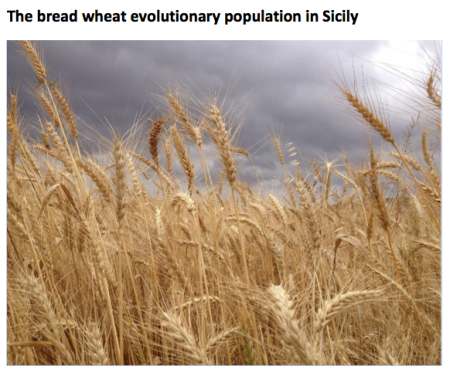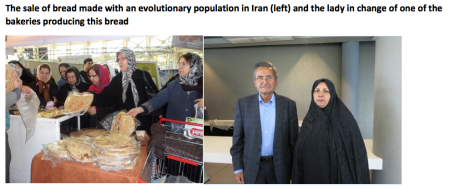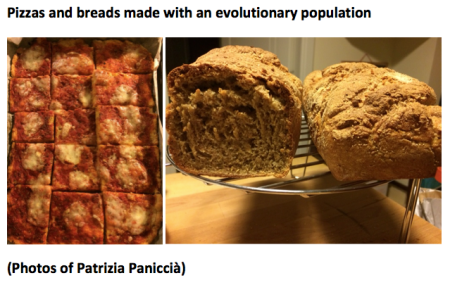News that the Organic Research Centre has launched the ORC Wakelyns Population, an unusual new wheat “variety”, inspired Dr Salvatore Ceccarelli to write this blog post for us about his own efforts in a similar vein. He describes a different breeding paradigm, one based on providing farmers with lots of diversity, rather than with a single Next Big Thing.
One of the global issues most frequently debated today is the loss of biodiversity. What’s not often mentioned is that this can happen within agricultural as well as natural ecosystems, and that it can then have an effect on the ability of farmers to adapt to climate change, on food security and on human health.
In 2008, at ICARDA, we dusted off the old idea of evolutionary breeding ((Suneson, C. A. (1956) An evolutionary plant breeding method. Agronomy J. 48:188-191)) to bring biodiversity back into farming systems. We made large, widely diverse populations of barley, bread wheat and durum wheat by mixing lots of F2 lines. And I mean lots: 1600 in the case of barley, 2000 in the case of bread wheat and 700 for durum wheat. The populations went to different countries, including Jordan, Algeria, Eritrea, Iran, and lately even Italy. In Ethiopia, a specific population was made based more specifically on Ethiopian germplasm.

The objective was to provide farmers with what could be defined as an evolving gene bank. Because of natural crossing, the seed which is harvested from these populations is never genetically the same as what was sown. In other words, the populations evolve continuously, becoming progressively better adapted to the conditions (soil, climate and agronomy) in which they are grown — and in the long term to climate change.
We thought that as the populations evolved, farmers would be able to use them as a source from which to select, possibly with the participation of scientists, ever better adapted varieties. However, it went further than that. Iranian farmers started reporting that the evolutionary populations could themselves be used as crops, as they were high yielding, stable and did not require chemical protection against pests. As a result, the evolutionary populations of barley and wheat spread through 17 provinces in Iran, and new evolutionary populations are being established in rice and corn.
But perhaps the best finding was the one made by Iranian bakers: the bread made with the evolutionary population of bread wheat soon became a commercial success, not only because of its taste and flavour, but also because it was tolerated by people affected by allergies.

We are now having the same experience in Italy, where evolutionary populations of barley, durum wheat and bread wheat are grown in several regions: in Marche, bread made with the flour of the bread wheat population is now in great demand.

And an evolutionary population of zucchini, of all things, is currently grown by an organic farmer and new populations are being formed in beans and lettuce.
All these cases show that cultivating diverse populations can combine increasing biodiversity in farmers’ fields, adapting crops to climate change, and producing more, healthier, tastier food.
News and knowledge about evolutionary breeding are rarely shared around the web and I am happy to read more about it. A recent article in Farming Matters told the story of the Evolutionary Plant Breeding programme led by the Centre for Sustainable Development (CENESTA) in Iran. Find it here. Somehow I’m sure conceptual bridges could be build to link EPB with darwinian agriculture. I feel it would make sense though I did not give it any thought just yet. And what about evolutionary animal breeding? Would that make sense too?
I’m a bit dubious about the `progressively adapted to conditions’. If that is general, why do farmers replace seed stocks with new varieties, often very frequently? And what about pest and disease problems? When I was attached to the FAO Katumani project in Kenya about 25 years ago, local varieties (collected by me) were screened and the better ones made into composites for direct release to local farmers. I have never seen this written up.
What you mention is very similar to the Seeds for Needs initiative, especially our work in East Africa. Screening and selectively introducing landraces works very well for a number of crops.
Adaptive traits such as flowering time are highly heritable and populations shift frequencies in response to rainfall, e.g. length of the rainy season (see the French studies on West African sorghum and millet). The principle behind a higher pest and disease resistance would be a host-diversity effect, nothing related to evolutionary shifts in the plant population.
Is variety turnover related to climate change? I don’t think we have a lot of evidence for that. In this paper I have tried to explain why Guatemalan farmers regularly replace maize varieties for maize. I hypothesize that farmers do not want to have populations in genetic equilibrium with their environment for agronomic reasons, e.g. they want shorter cycles than what they would obtain under normal selection of ears after harvest (as ear size is positively correlated with days to flowering). If they would do mass selection in the field for early flowering, they would maintain or decrease time to flowering and would not need to introduce any seeds from other locations where the growing cycle is shorter. But they generally don’t do this.
Under a stable climate, selection pressure towards long cycles would also be a reason to keep introducing seeds. The French studies above showed that diversity present locally is sufficient to adapt to climate change. No introductions were necessary.